Publications on Children
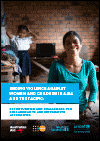
Resource | Publications,
Violence against women and children are linked. These harms share risk factors, including a lack of responsive institutions and weak legal actions against violence. These forms of violence are also both fueled by the harmful social norms that condone violent discipline, promote toxic masculinity, prioritize family reputation and blame victims – all of which perpetuate gender inequality. Intimate partner violence (IPV) and VAC often co-occur within spaces and relationships of trust, such as in the home or in schools. Evidence indicates that children in households affected by IPV are more likely than other children to experience violent discipline by both male and female caregivers. Further, witnessing IPV may have long-term health and social consequences similar to the impact of direct abuse.
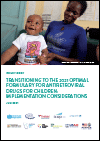
Resource | Publications,
Antiretroviral treatment optimization is a key pillar in the AIDS Free agenda to reach the goal of ensuring 95% of all infants and children have access to lifesaving treatment.
This policy brief outlines key considerations to facilitate effective transition to more clinically appropriate regimens as optimal antiretroviral medicines and dosage forms become available.
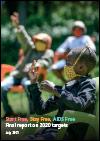
Resource | Publications,
Since the framework was launched, UNAIDS and partners have reported annually on progress towards achieving these targets. Since the deadline for achieving the targets passed in December 2020, this is the final Start Free, Stay Free, AIDS Free progress report. Although the targets were global, partners identified 23 countries for intensified focus under the framework. This report specifically highlights progress against the targets in focus countries.
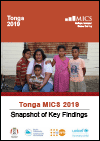
Resource | Publications,
MICS surveys measure key indicators that allow countries to generate data for use in policies, programmes, and national development plans, and to monitor progress towards the Sustainable Development Goals (SDGs) and other internationally agreed upon commitments. The objective of this snapshot of key findings is to facilitate the dissemination and use of results from the Tonga MICS, 2019. The survey methodology and detailed tabulations based on the data collected are available in the Survey Findings Report.
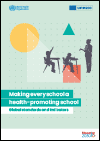
Resource | Publications,
The right to education and the right to health are core human rights and are essential for social and economic development. Now, more than ever, it is important to make all schools places that promote, protect and nurture health; that contribute to wellbeing, life skills, cognitive and socioemotional skills and healthy lifestyles in a safe learning environment. Such schools are more resilient and better able to ensure continuity in education and services, beyond the delivery of literacy and numeracy.
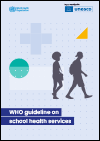
Resource | Publications,
School health services (SHS), as defined in this guideline, are services provided by a health worker to students enrolled in primary or secondary education, either within school premises or in a health service situated outside the school. Most countries have some form of SHS, but many such programmes currently are not evidence-based, are not implemented well, are underfunded and/or are delivered with limited reach and scope. In all WHO regions, school-age children and adolescents (those aged 5–19 years) experience a range of largely preventable health problems, including unintentional injury, interpersonal violence, sexual and reproductive health issues, communicable diseases, noncommunicable diseases and mental health issues.
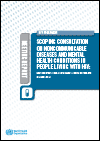
Resource | Publications,
In April 2019, WHO convened an expert scoping consultation in Geneva, Switzerland consisting of policy-makers, academics and partners from the HIV, noncommunicable diseases and mental health communities to discuss current evidence of chronic noncommunicable disease, the burden and risk among people living with HIV, review current norms and standards and ultimately to set priorities for technical areas and interventions for co-managing major non communicable diseases and mental health conditions among people living with HIV; and to inform the update of the 2016 WHO HIV consolidated guidelines on the use of antiretroviral drugs for treating and preventing HIV infection.
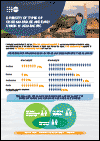
Resource | Fact Sheets,
In the Asia and Pacific region, 23 million adolescents aged 15-19 years are currently married or in union. Child marriage and early union (formal or informal, before the age of 18 years) is common throughout much of the region, with the highest prevalence in South Asia and some Pacific countries. The legal age of marriage should be 18, and all countries should enact legislation to prohibit forced marriage and remove exemptions that allow nonconsensual child marriage. However, treating all unions under the age of 18 years as forced and invalid can have harmful consequences. Enforcement of laws can cause harm to the girls we are intending to protect. Understanding the different forms of early marriage and union in the context of adolescent development and agency is critical to ensuring the implementation of child marriage legislation does not cause harm.
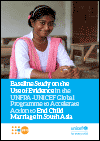
Resource | Publications,
This study was conducted in Bangladesh, India and Nepal at the start of Phase II (2020-2023) to establish a baseline measuring the programme’s use of evidence in programming, design and delivery, advocacy and monitoring and evaluation (M&E). The study also reviews the major activities outlined in the Phase II Work Plans for the three countries. The study develops a set of core indicators and tools for measuring the use of evidence that can be replicated at the mid-term and at the end of Phase II.
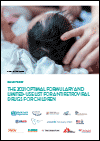
Resource | Publications,
The WHO 2021 guideline promotes the use of optimal antiretroviral treatment (ART) regimens in all populations. Though new, more effective and better tolerated options with a higher genetic barrier to resistance are now available for adults, optimized treatment options for children lag significantly behind.
This sixth edition of the Optimal Formulary and Limited-use List supports the transition to optimal WHO-recommended ART regimens for infants and children, while giving due consideration to the rapidly evolving treatment landscape and the risks inherent in the uncertain timelines for pediatric drug development.





